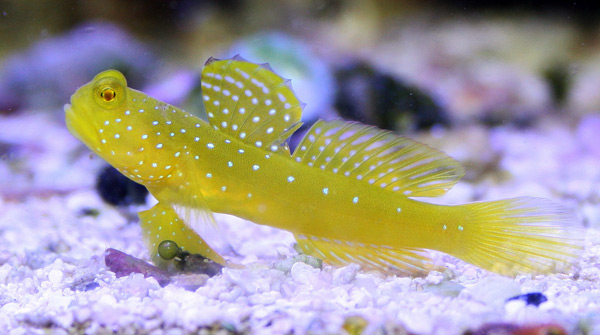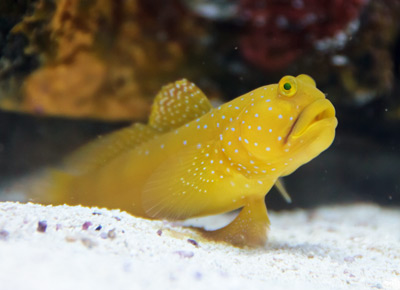Marine aquarium hobbyists who maintain nano tanks, whether by choice or necessity, often find it challenging to acquire fish that are well suited to their diminutive systems. But in the yellow watchman goby (Cryptocentrus cinctus), they can get all the attributes they seek—small mature size, attractive coloration, hardiness, and interesting behavior—in a single package.
While the yellow watchman goby, aka the yellow shrimp goby or yellow prawn goby, can be housed by itself with no problems, in my opinion, it’s much more interesting and rewarding to keep it as it commonly occurs in nature—with an Alpheus spp. pistol shrimp (e.g., Alpheus bellulus, the tiger pistol shrimp) sharing its burrow.
In this mutualistic symbiotic relationship, the shrimp, which has very poor eyesight, continuously excavates the burrow while the goby stands sentinel against predators. Almost at all times, the shrimp keeps at least one of its antennae in contact with the goby so it can immediately sense when danger is near via the goby’s body language.
Physical traits
C. cinctus has a torpedo-like body shape; two distinct dorsal fins; a rounded caudal fin; the typically goby-esque fused pelvic fins; high-set, bulbous eyes; and an oversized, “frowning” mouth. This species may be either yellow to golden brown or whitish in base color with white to light-blue dots clustered primarily on the anterior half of the body and speckled through the dorsal fins. Maximum size is around 4 inches.

Feeding
Captive specimens should adapt to standard aquarium fare quite readily. Offer small, meaty items, such as mysid and brine shrimp, chopped clam or crustacean flesh, or frozen carnivore blends, at least twice daily. Symbiotic alpheid shrimps will accept these same foods along with many others, though it may be necessary to target feed them in the burrow, using something like sinking pellets, if tankmates are grabbing up all the food before they can get any.
Housing
As mentioned, C. cinctus doesn’t need a large aquarium. I would put minimum housing at 20 gallons. Also, a mixed substrate consisting of sand and rubble must be provided for burrowing. This species is a good jumper, so be sure to keep the tank covered, especially while a new specimen is getting acclimated.
Compatibility
C. cinctus is relatively peaceful toward most heterospecifics, but it’s best to avoid keeping one with other shrimp gobies (including conspecifics, with the exception of mated pairs) or other species that are very similar in habits or the niche they tend to occupy in the tank. Of course, any predatory species large enough to swallow a watchman goby or its crustacean burrow mate must be ruled out as well.
This goby is generally a good candidate for reef systems, as it won’t pester or eat sessile invertebrates.




